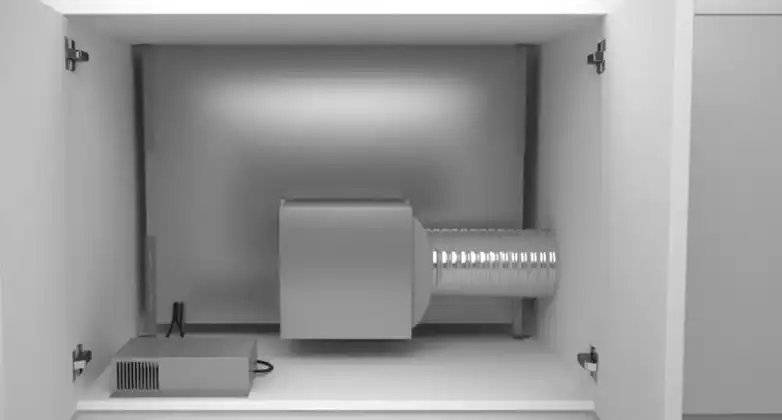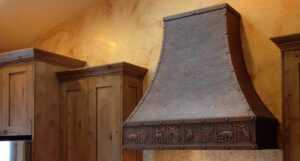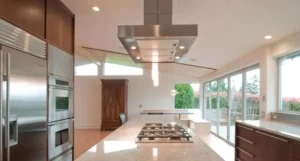For new homeowners or people who are renovating their kitchen, the question of how far can they go to the cooker hood is a crucial one. Since general knowledge dictates that a hood can only blow a certain amount of air out, understanding how far can it go is crucial.
In general, when ducting your cooker hood, you should not exceed 50 feet.
However, there’s more to that, which we will discuss in this article. So, read on.

How Long Can You Duct a Cooker Hood?
Let’s kick things off by addressing the fundamental question: How long can you really duct a cooker hood? The answer isn’t a simple one-size-fits-all, as it depends on various factors that come into play. However, here are some key considerations:
Manufacturer’s Recommendations: Start Here!
Your cooker hood’s manufacturer knows their product inside out. They’ve likely conducted extensive testing to determine the optimal ducting length for your specific hood model. That’s why it’s essential to consult the installation instructions and guidelines provided by the manufacturer. This document is your holy grail for understanding the recommended duct length, duct size, and other essential details.
Duct Size Matters
Duct size isn’t just about aesthetics; it plays a crucial role in determining the maximum ducting length. Larger ducts can accommodate higher airflow, which can allow for longer duct runs. Common duct sizes for residential hoods are 6 inches (150mm) in diameter, but larger hoods or commercial setups may require 8-inch (200mm) or even larger ducts. Before deciding on duct size, consider the size of your kitchen and the type of cooking you do to ensure you’re choosing a hood with adequate airflow capacity.
Airflow Capacity: A Numbers Game
Understanding your cooker hood’s airflow capacity is pivotal. It’s usually measured in cubic feet per minute (CFM) or cubic meters per hour (m³/h). The higher the CFM rating, the more air your hood can move. A higher CFM allows for longer ducting. Calculate the required airflow based on the size of your kitchen and the type of cooking you do to ensure your hood is up to the task.
The Duct Material Dilemma
Duct material matters more than you might think. Smooth, rigid metal ducting is the gold standard for long duct runs because it minimizes airflow resistance. It’s like a highway for cooking fumes to escape. Flexible or corrugated ducting, while convenient in tight spaces, can restrict airflow and should be used sparingly. If you have to use flexible ducts, keep them as straight and short as possible.
Bends and Turns: The Culprits of Resistance
Every bend or turn in the duct introduces resistance and decreases the maximum allowable duct length. Think of it like a winding road slowing you down on a road trip. Minimize the number of bends in your ductwork, and when you do need to make a turn, opt for gradual, wide-radius bends to reduce airflow restriction.
Vent Termination Tactics
Where your duct terminates outside your home is another factor to consider. You don’t want cooking odors and grease to come back in through windows, doors, or other air intakes. Make sure your vent terminates away from these areas to ensure efficient ventilation.
The Role of Inline Blowers
Sometimes, you might find yourself in a situation where you need to extend your ducting beyond what seems feasible. In such cases, consider using inline blower units. These are installed within the ducting system and act as boosters to increase airflow, allowing you to have longer duct runs.
The Verdict
Your range hood duct should be limited to the following lengths:
- A straight run should not exceed 30 feet.
- For a run with one elbow, limit it to 25 feet.
- If you have two elbows in your duct run, keep it within 20 feet.
It’s generally recommended to keep your duct as short as possible for optimal performance. When ductwork is overly long, there’s a risk that the kitchen air won’t effectively reach the outdoors. Additionally, back drafting may occur, meaning that air remains trapped inside the duct and can flow back through your hood and into your cooking space.
How to Decrease Duct Length to Accommodate Your Kitchen Setup
Now that you’ve got a grip on what determines the maximum duct length, let’s explore ways you can decrease it to fit your kitchen layout.
Opt for a More Powerful Hood
If extending the duct length isn’t practical, consider upgrading to a cooker hood with a higher CFM rating. A more powerful hood can compensate for a shorter duct run by moving more air and capturing cooking fumes effectively.
Reconfigure Your Kitchen Layout
If possible, reconfigure your kitchen layout to reduce the distance between your cooker hood and the outside vent. This might involve relocating your cooking appliance or adjusting the hood’s placement.
Use Straight Duct Runs
Remember that bends and turns reduce duct length. Try to design your ducting system with as few bends as possible. Use gradual bends when necessary to minimize airflow restriction.
Choose the Right Duct Material
Opt for smooth, rigid metal ducting to minimize airflow resistance. Avoid long stretches of flexible or corrugated ducts whenever possible, as they can hinder airflow.
Upgrade Ventilation Accessories
Consider installing an inline blower or an external blower motor if you need to extend your ducting beyond the manufacturer’s recommendations. These accessories can increase the hood’s overall performance and compensate for longer duct runs.
People Also Search For
Is it okay to exceed the manufacturer’s recommended duct length?
It’s generally not advisable to exceed the manufacturer’s recommendations for duct length. Doing so can compromise the hood’s performance, reduce efficiency, and potentially void your warranty. Always follow the manufacturer’s guidelines for the best results.
Can I use flexible ducting for my cooker hood?
While flexible ducting can be used in some cases, it’s best to limit its use and keep it as straight and short as possible. Rigid metal ducting is preferred for longer runs as it minimizes airflow resistance.
What if I have multiple bends in my ductwork?
Multiple bends and turns in your ductwork can significantly reduce the effective duct length. To compensate, consider using an inline blower to boost airflow.
Are there any building code requirements for cooker hood ducting?
Building codes can vary by location, so it’s essential to check with your local authorities or consult a professional to ensure your installation complies with local regulations.
Can I install a cooker hood without ducting to the outside?
While some cooker hoods can be installed in a recirculating mode (without ducting to the outside), this is generally less effective at removing cooking odors and airborne particles. Ducting to the outside is preferred for optimal ventilation.



